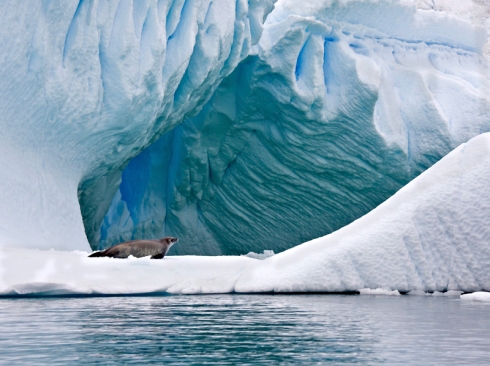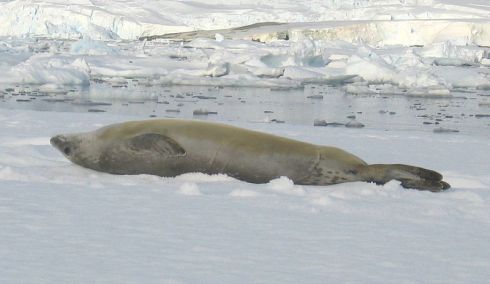You are currently browsing the tag archive for the ‘Lobodon carcinophagus’ tag.
The crabeater seal (Lobodon carcinophagus) is a pale-colored seal which lives on the pack ice around Antarctica. Adult crabeater seals have an average length of 2.3 meters (7 and-a-half feet) and weigh around 200 kg (440 pounds) however the largest male crabeater seals can weigh up to 300 kg (660 lb). The seals’ mass alters considerably over the course of a season as they gorge themselves in preparation for lean times (or—in the case of mothers—for nursing). Like other Antarctica seals, crabeater seals have slender bodies and long snouts. They are gifted swimmers—a talent which allows them to escape their two main predators, killer whales and leopard seals. They infrequently venture beyond the continental shelves of Antarctica (although very rarely one is spotted at New Zealand, Patagonia, or South Africa). They hunt along the pack ice and travel far inland to give birth. The seals give birth to one pup annually and they can live up to 40 years.
Crabeater seals can slither over land fairly well and they range farther onto continental Antarctica than any other indigenous mammal. Crabeater seal carcasses have been found up to 100 kilometers from the coast. So crabeater seals have whole swaths Antarctica to themselves (well aside from big weird penguins, lichens, and Norwegian explorers). Although they may theoretically eat a crab every now and then, the seals are misnamed. Their main prey is Antarctic krill, which they eat in huge quantities (as an aside, Antarctic krill is believed to have the greatest biomass of any single species on Earth). Although they do not have baleen like the great rorquals, crabeater seals have specialized krill-filtering cusps on their teeth which trap the krill and allow water to escape. When krill are not available, the seals can also feed on fish and squid.
Perhaps the most remarkable thing about crabeater seals is their sheer numbers. Other than humans (and our livestock) they are the most numerous large mammals on the planet. Caribou and wildebeests exist in herds of hundreds of thousands, but the crabeater seal population numbers in the millions. The full population of crabeater seals is unknown. Estimates range from 7 million to 70 million. Since they are pale colored seals darting between the crushing pack ice of an uninhabited continent we have a population estimate which is off by a factor of ten. The fact that so few people have seen them might explain why they are still so successful.




